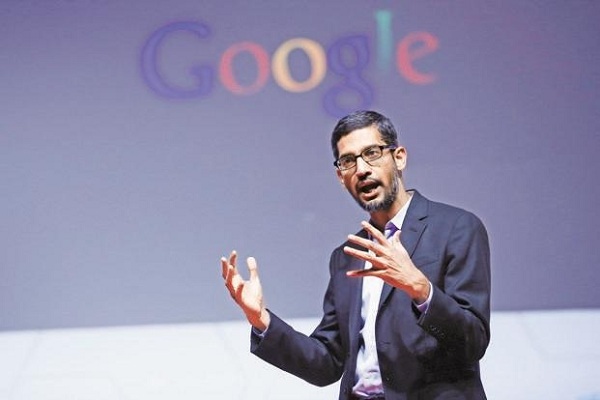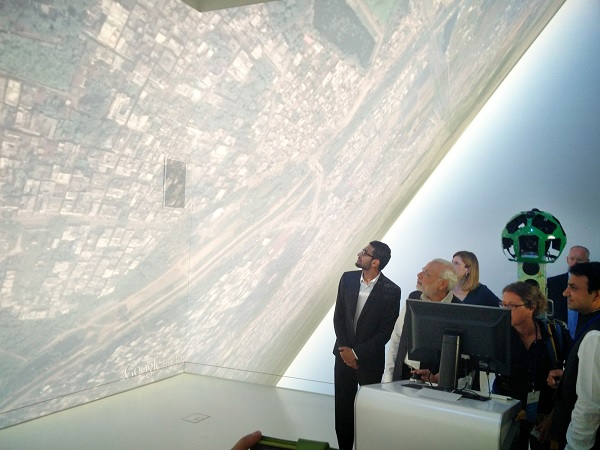
by Editor | May 25, 2021 | World
 By Arun Kumar
By Arun Kumar
Washington:(IANS) Google’s Indian-American chief executive Sundar Pichai sided with rival Apple in its battle over a court order to help the FBI access information on the encrypted iPhone used by a Pakistani-American shooter in San Bernardino.
Pichai Wedenesday directed followers to Apple Chief Executive Tim Cook’s open letter Tuesday night arguing that helping the FBI try to get into the phone used by Syed Rizwan Farook would sabotage the security of “tens of millions of American citizens.”
Farook and his Pakistani origin wife, Tashfeen Malik, gunned down 14 people at a social services agency Dec 2 in San Bernardino, California, before being killed in a shootout with police.
FBI Director James Comey said last week that investigators still haven’t been able to get at the information on Farook’s iPhone 5c.
A Riverside, California court Tuesday directed Apple to help FBI crack the phone by developing software to hack into one of its own devices.
In a series of tweets Wednesday evening, Pichai argued that even that would essentially put tech companies in the position of hacking their own customers:
1/5 Important post by @tim_cook. Forcing companies to enable hacking could compromise users’ privacy.2/5 We know that law enforcement and intelligence agencies face significant challenges in protecting the public against crime and terrorism 3/5 We build secure products to keep your information safe and we give law enforcement access to data based on valid legal orders 4/5 But that’s wholly different than requiring companies to enable hacking of customer devices & data. Could be a troubling precedent 5/5 Looking forward to a thoughtful and open discussion on this important issue.
The government, Cook contends, is asking Apple to create a “backdoor” to its own security systems.
“Up to this point, we have done everything that is both within our power and within the law to help them,” Cook wrote in a letter published on the company’s website.
“But now the US government has asked us for something we simply do not have, and something we consider too dangerous to create.”
Reacting to Cook’s stand, Republican presidential front-runner Donald Trump said he was floored that Apple had not volunteered to aid the FBI. “Who do they think they are?” he asked on Fox News.
Speaking to reporters in South Carolina, Senator Marco Rubio said he hoped the tech giant would voluntarily comply with the government’s request, but acknowledged the court order is far from a simple issue.
(Arun Kumar can be contacted at arun.kumar@ians.in)

by Editor | May 25, 2021 | Markets, Technology
 By Anirban Ghoshal
By Anirban Ghoshal
San Francisco: (IANS) Internet giant Google’s newly-appointed India-born chief executive Sundar Pichai took to the stage on Tuesday to launch two new smartphones, streaming gadgets and a new Android operating system (OS) to compete with rivals in the mobility space.
In an event on Tuesday that was streamed and watched across the globe, it also introduced upgrades to two apps – Google Play Music and Google Photos.
Before announcing the latest releases – two smartphones Nexus 5X and Nexus 6P, second generation Chromecast, an audio Chromecast and a new 10.2-inch tablet named Google Pixel C, Pichai said: “It was great receiving the Indian Prime Minister Narendra Modi to the Silicon Valley”.
Modi made a two-day trip to the West Coast where he met chief executives and founders of several top technology companies during his five-day US visit.
According to Google, the company has added 400 million new users to the Android ecosystem in one year. “Previously we had one billion 30-day period active users but now we have 1.4 billion 30-day active users,” Pichai said.
“With people in emerging economies moving to smartphones especially with our Android One initiative that offers high-quality yet affordable smartphones, we are on route to meet the target of getting the next billion users online,” he said.
He also said that more Chromebooks were being adopted in the US schools. “Nearly 30,000 Choromebooks were activated in the month of September alone. Our ‘Android for Work’ is also picking up with 10,000 firms already adapting it partially or completely,” he said.
The company’s latest iteration of the Android OS – Marshmallow – was also introduced on Tuesday. Google, which had first announced Android 6.0 Marshmallow at its I/O developer conference earlier this year, said that the new OS will be available to users on Nexus devices.
Although, the new version of Android will look similar, the company has made a number of tweaks to its mobile operating system in order to make using Android phones easier. Also there is a new smart battery-saving mode called ‘Doze’ mode that will put the device into sleep when it’s left unattended for a long time.
The newly launched smartphones, Nexus 6P and Nexus 5X – priced at $499 and $379 respectively, will come with Type-C USB, fingerprint sensor, large 1.55-micron pixels camera sensor and will run the latest Android operating system Marshmallow.
“There’s also a new fingerprint sensor called Nexus Imprint which will also open up fingerprint recognition to the entire app ecosystem,” Google said.
The company also announced a new “Nexus Protect programme” for $89 that would provide two years of coverage for both mechanical problems and accidental damage. Both the phones will be available for pre-order in select countries, including US, Britain, Japan and Ireland starting Tuesday.
The new Pixel C 10.2-inch tablet, which comes with a magnetic keyboard, will also run on Marshmallow. The magnetic keyboard, which will be available as an accessory for $149, connects to the tablet via Bluetooth.
Google said that the keyboard can go without charge for two months. Interestingly, the keyboard which works as a front cover for the tablet charges from its battery.
Earlier, Apple had launched a 13-inch tablet with a keyboard and a stylus to compete with other existing tablets in the market – especially the Microsoft Surface which claims to give laptop-like productivity on the go.
The chief executive also launched two new Chromecast streaming gadgets — one for streaming video and photos to a TV, and another one for streaming music to any audio entertainment hub or standard speakers.
The second generation video Chromecast, which has nearly sold over 20 million devices globally, has undergone a design change to look like a Carrom striker with the HDMI cable sticking out from one end.
The new streaming device comes with three Wi-Fi antennas supporting the newer dual-band Wi-Fi 802.11ac version, which Google claims, will provide a “more robust, high quality streaming experience for less buffering than you would have found previously with the Chromecast”.
The new Chromecast Audio operates in a similar manner to the video version of Chromecast, but connects to a pair of speakers or a hi-fi via a 3.5mm line out, optical out or standard phono (RCA) jacks. “We’re trying to do for hi-fi what we’ve done with the TV – turn your hi-fi into a smart hi-fi,” said a Google spokesperson.
Both the new Chromecasts are powered by a microUSB cable and will be available in the next week costing $35.
(Anirban Ghoshal can be contacted at anirban.g@ians.in)

by Editor | May 25, 2021 | Corporate, Corporate Governance

Prime Minister,Narendra Modi being shown the demos of cutting-edge Google technology including Project Iris & Google Earth at Google campus, in Silicon Valley, California. The CEO, Google, Sundar Pichai is also seen.
San Jose:(IANS) Prime Minister Narendra Modi on Sunday chaired a roundtable on renewable energy with top energy CEOs and experts during which he emphasised India’s commitment to realize the vision of 175 GigaWatts of clean energy by 2022.
At the roundtable, which was also attended by US Energy Secretary Ernest Moniz, Modi gave an overview of initiatives undertaken in India in the area of renewable energy, such as Kochi airport becoming a solar-powered airport and solar panels being installed over a canal in Gujarat as another example of the use of renewable energy.
He said that early next month, a district court in the tribal belt of Jharkhand will become entirely solar-powered. Modi also mentioned coal gasification as an important area of research. He expressed confidence of a renewable energy revolution over the next decade, said an official statement.
Modi said there is massive scope of investment in the clean energy sector, for example, through the Railways, where 100 percent FDI has been allowed. He said the government is working to address issues in regulation, and address the financial health of Discoms.
Besides, Moniz, the meeting was also attended by Prof. Steven Chu, former US Secretary of Energy.
Top energy CEOs and investors, including Ahmad Chatila, CEO SunEdison; Nikesh Arora, President and COO, Softbank; K.R. Sridhar, CEO, Bloom Energy; Jonathan Wolfson, CEO, Solazyme; John Doerr, Venture Capitalist; and Ira Ehrenpreis of DBL partners were present.
Prof Arun Majumdar, Prof Roger Noll, Dr. Anjani Kochar, and Prof. Sally Benson, all from Stanford University, participated.
Among the views expressed at the roundtable, was a clear assertion that India has the makings of becoming the “clean energy world capital”.
The participants said that clean and renewable energy will soon be an inexpensive energy option, with electricity storage becoming cheaper.
Participants were of the view that states and cities in India should be allowed to take the lead in clean energy initiatives. A related thought was that the current grid is not designed for carrying the 175 GigaWatts (GW) of renewable energy that India is targeting, and therefore a complimentary effort is required on the grid side.
Private investment was emphasized as vital for realizing the vision of 175 GW, with a parallel example being given of how Israel had solved its water shortage using private investment, said the official statement.
Experts were of the view that India has to address issues in four key areas – viz. technology integration; finance; regulatory frameworks; and the right talent pool. They also expressed concern at the financial status of power distribution companies (Discoms) in India.
The CEOs present gave a brief overview of the technologies and innovations being used in their companies. In addition to solar and wind energy, biomass was also suggested as a key provider of clean energy.


